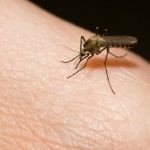If you’re like approximately 80% of North Americans, you have or will experience back pain at some point in your life. Correct posture, body mechanics, and stretching play a vital role in preventing back pain and can be implemented throughout your day using simple techniques. Read more
Sitting Down On The Job
 Sitting improperly is often the greatest cause of back pain. Supporting your back while driving, at work or at home can help reduce strain. This can be done with a rolled towel, small pillow or a specially designed seat support, available at many medical supply stores. Remove the support every half hour for five minutes to give your lower back a change of position. Ensure that your head is positioned with your ear in line with your shoulder and your chin parallel with the floor.
Sitting improperly is often the greatest cause of back pain. Supporting your back while driving, at work or at home can help reduce strain. This can be done with a rolled towel, small pillow or a specially designed seat support, available at many medical supply stores. Remove the support every half hour for five minutes to give your lower back a change of position. Ensure that your head is positioned with your ear in line with your shoulder and your chin parallel with the floor.
Avoid leaning to one side, sitting for long periods of time, raising your legs, and using overstuffed furniture that does not offer adequate support.
When working at a desk, your chair should be pulled close to the desk. An office chair with short arm rests will allow this. You should be able to adjust the height, back rest, and seat of your chair. Adjust the back rest spring so that the back rest moves with you.
Using a swivel chair enables you to work without twisting your back. Place objects such as computers as close to you as possible to minimize the amount of twisting and turning you need to do. When you lean forward at your desk, bend forward at the hips instead of rounding your lower back. Also, sit with your feet flat on the floor and your knees above your hips. If you are unable to adequately raise your knees, try placing your feet on a stool. These positions will allow you to keep your back straight and in good alignment.
Talking on the Phone Can Be a Pain in the Neck
Holding the phone between your ear and shoulder is a common cause of neck pain. To alleviate this, use headsets or other hands-free devices.
After sitting for a prolonged period, it is helpful to straighten your back to an upright position and, if possible, stand and walk around.
Standing Still
If you have to stand for long durations try to shift your weight from one foot to the other, or place one foot on a stool. Back health is related to good posture, so make sure you are standing tall with a flattened low back, relaxed knees, and tightened abdominal muscles. This will soon become a habit and help prevent low back pain.
Lifting and Carrying with Ease
When picking up an object, apply proper lifting techniques regardless of its size or weight. This means bending at the knees, not the waist, tucking in the buttocks and tightening the abdominals. Most importantly, never twist to pick up an object. Always face it squarely.
In addition, when you carry an object, hold it at waist level and close to your body. Avoid carrying an object on one side of your body. If you must carry to one side of the body, make sure to alternate sides. This is a great tip for mothers when carrying their babies.
A Good Night’s Sleep
The ideal sleep position is on your side with the knees drawn up on a mattress that is flat, firm and comfortable. If you sleep on your back, place a pillow under your knees. You will want to avoid sleeping on your stomach, staying in one position for too long, or extending the arms overhead.
Don’t Forget Exercise
Regular exercise will increase the strength and flexibility in your leg and back muscles, helping you avoid excessive strain and possible injury. Some forms of exercise, such as yoga and tai chi, may help relieve or prevent back pain by increasing flexibility and reducing tension. However, these exercises should not be done if they are uncomfortable or place a strain on the back. And don’t neglect strength training; strong abdominal, back and leg muscles play a vital role in helping you maintain good posture and body mechanics.
So there you are at the beginning of a new year, newly single. What’s your plan?
 Whether you were the one who left, or the one who did the leaving, it is probably a good idea to take some time to process your last relationship. Jumping into a new relationship while the first one has barely ended may temper some things – perhaps you will not think so much of your loss or on the bad things that happened in the previous relationship – but there are some negatives to this equation as well. One of the downsides of ignoring the past is that it has a way of festering and making a reappearance, sometimes in undesirable ways. I once knew a lady who after leaving an abusive, alcoholic partner, immediately started a new relationship. In her new relationship, every time her new partner would have a beer, she would have a severe anxiety attack and go into a state of crisis. She had not given herself sufficient time to heal from her old relationship before getting into a new one and, as a result, past issues were making their way into the new relationship. The situation generated considerable conflict in the new relationship.
Whether you were the one who left, or the one who did the leaving, it is probably a good idea to take some time to process your last relationship. Jumping into a new relationship while the first one has barely ended may temper some things – perhaps you will not think so much of your loss or on the bad things that happened in the previous relationship – but there are some negatives to this equation as well. One of the downsides of ignoring the past is that it has a way of festering and making a reappearance, sometimes in undesirable ways. I once knew a lady who after leaving an abusive, alcoholic partner, immediately started a new relationship. In her new relationship, every time her new partner would have a beer, she would have a severe anxiety attack and go into a state of crisis. She had not given herself sufficient time to heal from her old relationship before getting into a new one and, as a result, past issues were making their way into the new relationship. The situation generated considerable conflict in the new relationship.
Some people decide they are going to be ‘totally honest’ when they start a new relationship. And so, when they meet someone new, they tell it all. People do this with the misconception that by telling all there is to tell about themselves right at the get-go will somehow help them to avoid a future debacle of the kind they have just survived. If only we could prevent relationships from collapsing by disclosing all our secrets right at the start, we would have found the cure to relationship breakdown. In truth, there is such a thing as saying too much and it applies as much to relationship number 5 as it does to number 1. The best course is to be balanced, to make appropriate disclosures, as one normally would, over time. And some things really should be your own to keep – nobody needs to know everything there is to know about you.
I know of people who have gone on dating and sexual free-for-alls after exiting a relationship. There is no evidence to suggest this is therapeutic medicine for hurt or pain a person may have suffered in a relationship gone awry. If you are considering this, it might help you to know that no matter how hurt you are now you can be hurt more yet. Be careful and take a balanced approach to your life. Later, you will be glad you did.
Let me also say a word about support: there is good support and then there is bad support. Good support is the kind that listens to you without judging you, is judiciously available to you, and when you need it, gently challenges your inaccurate view of the events of your life. Bad support is the kind that does nothing but work you up further, provides unwanted advice, is pushy, foists its own views upon you and gets mad when you don’t do what it wants you to. Good support is invaluable, bad support is worthless at best and terribly destructive at worst. When you are looking for a shoulder to cry on – which we all need from time-to-time – choose the good support kind and keep away from people who want to vent while using you as a vehicle.
Here are some thoughts on moving ahead in a good way:
- Try and see the past as you having made an effort at love, the relationship may not have lasted but at least you tried.
- Take your time getting back into the dating game, 6 months to a year to process things is not too much to ask of yourself.
- Most likely dating is the same as it always was, but we probably find each other in more technologically driven ways. Get to know some of the technologies people use now to find each other before you start dating and make it a fun experience.
If you are struggling emotionally get some help to develop the balance you want to have when you enter a new relationship.
Otherwise, the year is young, you are single and there is a whole world out there waiting for you, when you are ready to step out again.
Alexander Dhand is a Registered Psychologist in Calgary. He practices in the areas of Addictions, Depression, Anxiety, Stress, PTSD, Chronic Pain and Relationships via email at and through Twitter at Twitter.com/calgarypsych
If you’re travelling to a tropical country, you probably know that limiting your exposure to mosquitoes is paramount in the fight against diseases such as malaria, dengue fever, Japanese encephalitis and yellow fever. But you may not know how to keep those critters from biting. Here are some personal protective measures you can use to prevent mosquito bites.
 Insect Repellents
Insect Repellents
Insect repellents applied to skin interfere with the mosquitoes’ chemo receptors for carbon dioxide and lactic acid. There are several types of insect repellents available on the market. Some are ‘natural’ repellents, such as citronella, which typically lasts a short time and has limited efficacy. Others are chemical repellents, such as DEET.
DEET is extremely effective against mosquitoes and, after many years, still maintains an excellent safety profile. The concentration of DEET does not imply its efficacy, but rather the length of time you can go between applications. Concentrations of 30% are recommended if you are travelling to a malarial region. Repellents should be applied to exposed skin, particularly at dusk and dawn, with careful use around the face and mucous membranes.
Mosquito Nets
Mosquito nets are used as a physical barrier to prevent insect bites while sleeping. The nets must be free of tears, draped properly above the bed and completely tucked under the mattress. For optimal usefulness, the nets should be impregnated with an insecticide such as permethrin. Pore size should be a maximum of 1.5 mm although this is not as significant if the net is impregnated.
Protective Clothing
Protective clothing provides a physical barrier that prevents mosquitoes from being able to feed. Clothing should cover arms, legs, and ankles (long-sleeves, pants and socks). Light colours and loose clothing are best. Ideally, such clothing should be used during those times of the day when mosquitoes are biting.
The best way to avoid mosquito bites is to combine all of the different preventative techniques.
According to the Canadian Pediatric Society, the majority of kids in Canada aren’t active enough, and many of them are obese.
 Thanks to poor eating habits and lack of physical exercise, children simply aren’t as healthy as they should be. As a parent, you can play a big role in improving the activity levels of your children and helping them achieve peak health.
Thanks to poor eating habits and lack of physical exercise, children simply aren’t as healthy as they should be. As a parent, you can play a big role in improving the activity levels of your children and helping them achieve peak health.
Physical activity has numerous benefits for children. It helps them manage their weight, strengthens the heart, and leads to strong bones and muscles. Fit kids feel better about their bodies and themselves and they may be more relaxed and able to sleep better. Flexibility, posture and balance are all positively impacted by increased activity.
Here are a few tips to help you give your children the benefits of increased physical activity and healthy eating:
Get Healthier as a Family
Set a goal to improve the family’s health, not just the health of one child. Sit down as a family and plan healthy meals, throw out junk food and identify fun physical activities you can do together.
Look for Ways to Increase Activity
Sports and dance classes are great ways to incorporate activity in your child’s day, but an hour of dance or soccer a week isn’t enough. Put limits on sedentary activities such as watching TV and encourage children to fill their time with bike rides, tobogganing, and other activities. You can also give your child active chores like shovelling the driveway and carrying the groceries when you walk home from the store.
Encourage Smart Eating Choices
Healthy eating is about making good choices as often as we can. Replace unhealthy snack foods with fruit, vegetables and foods with lots of bran, wheat and rye fibre. Make water the most easily available beverage in the house and, if you do buy junk food, get the smallest package possible.
For more ideas, visit: Caring for Kids
You already know that cruciferous vegetables—broccoli, cauliflower, brussel sprouts, kale, cabbage and bok choy—are good for you. Now research is showing that they may be grocery store super foods. Read more
 It is common knowledge that cruciferous vegetables contain phytochemicals, vitamins, minerals and fibre, half of which is cholesterol-lowering soluble fibre. These are all important to your health.
It is common knowledge that cruciferous vegetables contain phytochemicals, vitamins, minerals and fibre, half of which is cholesterol-lowering soluble fibre. These are all important to your health.
But did you know that eating cruciferous vegetables may help lower your risk of cancer? A review of several research studies published in the Journal of the American Dietetic Association suggests a link between cruciferous vegetable intake and protection against cancer.
Studies that tracked the nutrition intake of people over time have found that diets high in cruciferous vegetables are associated with lower rates of certain types of cancer, such as prostate cancer.
Several different components found in cruciferous vegetables have been linked to the lower cancer risk. In addition, the compounds found in these vegetables act in synergy with each other. According to the American Institute for Cancer Research, they have shown the ability to stop the growth of cancer cells for tumors in the breast, uterus, colon, liver, and cervix.
Another way cruciferous vegetables may help to protect against cancer is by reducing oxidative stress caused by free radical damage in the body.
So the next time you are in the produce aisle, give these vegetables a try.
Per 1 cup: | Broccoli | Cauliflower | Cabbage | B. Sprouts | Bok Choy | Kale |
|---|---|---|---|---|---|---|
(steamed) | (frozen, cooked) | (raw) | (cooked) | (cooked) | (cooked) | |
Calories | 44 | 34 | 22 | 60 | 20 | 36 |
Fiber | 5g | 5 | 2 | 4 | 3 | 3 |
Vitamin A | 33% DV | 1% | 2% | 16% | 62% | 137% |
Vitamin B-2 | 16% | 9% | 3% | 11% | 10% | 8% |
Vitamin B-6 | 17% | 12% | 7% | 21% | 22% | 14% |
Vitamin C | 165% | 75% | 38% | 129% | 59% | 71% |
Folic Acid | 23% | 18% | 10% | 23% | 17% | 4% |
Magnesium | 12% | 5% | 4% | 10% | 6% | 7% |
Potassium | 14% | 7% | 6% | 14% | 18% | 8% |
Omega-3s | 200 mg | 140 mg | 60 mg | 260 mg | 100 mg | 100 mg |
Buying and cooking tips
- To avoid the strong sulfur smell, avoid overcooking these vegetables.
- Add raw broccoli and cauliflower to your veggie platters and salads for an added crunch and a big nutrient boost.
- Chop cruciferous veggies and add them to soups, stews and casseroles.
- If your broccoli has yellow in it or is limp and soft, it is likely old. Don’t buy it. Look for firm florets with a dark green or bluish hue on the top. They typically contain more vitamin C and beta carotene than florets with lighter green tops.
Cauliflower Poppers Recipe
Ingredients:
- 1 spray(s) cooking spray
- 1 small head(s) cauliflower
- 1/2 tsp ground cumin
- 1/2 tsp chili powder, or more to taste
- 1/2 tsp table salt
- 1/2 tsp black pepper
Cooking Time: 10 minutes
Servings: 4
Preparation Time: 5 minutes
Directions:
Preheat oven to 400°F. Coat a baking sheet with cooking spray.
Cut cauliflower into bite-sized pieces (about 4 cups). Place cauliflower in a medium bowl and add cumin, chili powder, salt and pepper; toss to coat.
Spread cauliflower on prepared baking sheet and bake about 10 minutes until cauliflower is tender, but not mushy, stirring halfway through.
This is delicious and healthy. Serve it with a side of balsamic vinegar.
Chemical peels are a safe, effective treatment for exfoliating the outer layer of rough surface cells on the face and body.
The word ‘chemical’ makes some people apprehensive, but chemical peels are actually typically made from natural ingredients such as apples and pineapple. Lactic acid is used for its hydrating properties. A derivative of milk, lactic acid has been a beauty secret for centuries. From Cleopatra to Polynesian brides who soaked in milk and yogurt, natural acids have been used to soften skin and give the face a youthful glow. Here are the answers to common questions about chemical peels.
Can Chemical Peels be Used on All Skin Types?
 Chemical peels are beneficial for most skin types. They strengthen the skin, increasing cell turnover. This promotes the production of healthy collagen and elastin. They are useful for people with dry skin because moisturizer provides little benefit if the skin is covered with a layer of dead skin cells. Chemical peels allow moisturizers and treatment serums to penetrate deeper into the tissue, increasing moisture levels in individuals suffering from the dry, harsh, Calgary weather. Individuals suffering from mild acne will also experience relief from blocked pores since chemical peels facilitate the efficient absorption of medicated acne products.
Chemical peels are beneficial for most skin types. They strengthen the skin, increasing cell turnover. This promotes the production of healthy collagen and elastin. They are useful for people with dry skin because moisturizer provides little benefit if the skin is covered with a layer of dead skin cells. Chemical peels allow moisturizers and treatment serums to penetrate deeper into the tissue, increasing moisture levels in individuals suffering from the dry, harsh, Calgary weather. Individuals suffering from mild acne will also experience relief from blocked pores since chemical peels facilitate the efficient absorption of medicated acne products.
Can I Return to Work Immediately After I am Treated with a Chemical Peel?
Many people fear that chemical peels will cause severe injury to the skin or dramatic redness on the face, interrupting their daily routine. This is not the case with all peels. In fact, many people enjoy the appearance of their skin immediately after treatment with the Lunch-time Enzyme Peel. Highly effective, this peel is delivered in a series of six treatments and there is no need to interrupt your daily routine. The peel consists of salicylic acid, pineapple enzyme, papaya enzyme, pomegranate, cranberry and microalgae. Each ingredient plays a specific role in anti-inflammation, anti-oxidization or strengthening of the cell membranes.
What is the Jessner Peel?
The modified Jessner Peel also uses a salicylic acid but includes lactic acid for its soothing and softening properties. Resorcinol reduces hyper-pigmentation and removes thicker rough-textured dead cells. This peel exfoliates and strengthens the collagen structure with Resveratro, which also destroys free radicals. Raspberry and Lyccopene are included for their anti-oxidizing properties. The Jessner Peel may cause some peeling, temporary darkening of dead surface skin and some redness. We advise that no special events are planned immediately after this treatment. Most people state that the skin feels dry and that they have mild peeling but can continue with their daily life.
Are Chemical Peels Painful?
Chemical peels are not painful. You may feel a warm tingle on your skin and may experience an itchy sensation that is not unbearable. The length of time a product is left on the skin depends on the peel type, individual tolerance and skin condition and can range from 5 to 15 minutes. Your visit will take less than half an hour. SPF 30 is mandatory to prevent sun damage to the healthy exposed skin. A professional mineral makeup may be used after the treatment.
Book your complimentary skin analysis at Preventous today and discover which chemical peel is right for you!
